| Reviews & Columns |
|
Reviews DVD TV on DVD Blu-ray 4K UHD International DVDs In Theaters Reviews by Studio Video Games Features Collector Series DVDs Easter Egg Database Interviews DVD Talk Radio Feature Articles Columns Anime Talk DVD Savant Horror DVDs The M.O.D. Squad Art House HD Talk Silent DVD
|
DVD Talk Forum |
|
|
| Resources |
|
DVD Price Search Customer Service #'s RCE Info Links |
|
Columns
|
|
|
Fernando Di Leo Crime Collection
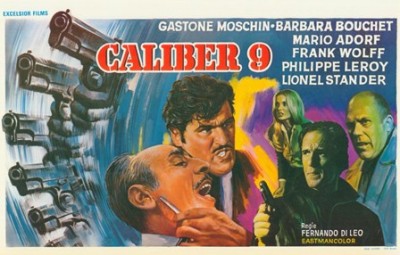
On the tangled family tree of Italian cinema, the films of Fernando di Leo grow from the same searingly colorful, genrefied, pulpy branch as those of Dario Argento and Lucio Fulci, far removed from those well-sculpted, more prominent limbs bearing the fruits of your Antonionis, Bertolluccis, Viscontis, and Pasolinis. The nonchalantly all-out luridness embraced by di Leo--and exemplified by three of the four gangster films now presented on Blu-ray for the first time in RaroVideo's The Fernando di Leo Crime Collection--owes much more to the populist, juicy titillations of Raffaello Matarazzo's melodramas than to the realism of Rossellini or de Sica, more to the hyperstylized, antirealist spaghetti Western than the probing angst and profundity of L'Avventura or Dillinger is Dead. (In fact, di Leo cut his teeth as a filmmaker by taking on various roles in the thriving Italian spaghetti Western industry of the '60s, which churned out hundreds of them a year.) These four selections from the peak of the di Leo filmography--the "Milieu Trilogy" comprising1972's Caliber 9 (Milano, Calibro 9) and The Italian Connection (La Mala Ordina), 1973's The Boss (Il Boss), as well as the later and lesser Rulers of the City--are, in the context of the director's more widely known and "respectable" compatriots, a perfect example of what the great American critic Manny Farber meant by "termite art" as opposed to "white elephant art." They're utterly unpretentious entertainments that forge heedlessly onward, with no Big Ideas other than to thrill, divert, and sometimes shock or arouse. But in the process they throw out the rule book and take desperate, skin-of-their-teeth technical and narrative risks that frequently result in a unique sort of cinematic beauty, a striking stylishness that the classier "white elephant" kind of film couldn't approach even if it wanted to.
The disreputable-and-loving-it approach pays off to a significantly higher degree in the Milieu Trilogy than in the inferior Rulers of the City. Caliber 9 and The Italian Connection both take place in a foggy, perpetually under-construction Milan that, far from being overrun by fashion models and designers as per the popular stereotype, is packed with ultra-violent mafioso of various ranks and extremes, hookers, and the seedy nightclubs where they all come together. Caliber 9 unfolds the existential fate (or is it just doom?) of gangster Ugo Piazza, just released from a three-year prison term and now on the run from his associates, who are convinced that he stole and stashed $300,000 before going in. He teams up with a now-outmoded (because honorable) old mob boss and the friend who takes care of him, and he rekindles his love affair with his go-go dancer girlfriend (Barbara Bouchet), but he will have to take on a powerful, double-and-triple-crossing mafia establishment if he wants to head off into the sunset with love, life, and wealth intact. As the violence escalates and the bodies pile up, Ugo's chances seem to grow slimmer and slimmer, and humanity eventually reveals itself to be even less trustworthy than even hardbitten and cynical gangster could have imagined.... This entry, with its coolly tragic tone and climax, is probably the best film of the bunch, and most redolent of di Leo's professed influence/role model, French master of existential gangster cool Jean-Pierre Melville (Le Samourai, Le Cercle rouge).
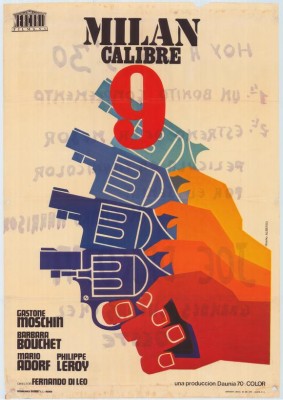
The appealingly (yet sometimes frighteningly) larger-than-life Mario Adorf, who played Ugo's arch-nemesis in Caliber 9, returns as the hero of The Italian Connection (thus titled in the U.S. in an obvious attempt to capitalize on the success of The French Connection; its actual title is La Mala ordina, or The Manhunt). Adorf is Luca Carnali, a junior godfather--again in corrupt, trashy, yet somehow scuzzily pretty Milan--who's honorable and dearly loves his estranged wife and daughter, whom he happily supports and protects despite his dalliances with the prostitutes he employs in his main line of business as a pimp. Luca lives comfortably enough and is content to just play by the rules (such as they are in his world), but the arrival of a couple of American hit men hired (by whom, it is left to the film's twisty-turny plot to reveal) to whack him for a false accusation of insubordination toward/theft from "the family." Our congenial godfather is left with only the goodwill of his ultra-leftist-bohemian friend Trini (Francesa Romana Coluzzi) and his own superhuman capacity for vendetta (which erupts in a series of amazingly over-the-top action sequences) to protect him and help him strike back when his shadowy enemies strike him too close to home; the film ends in a junkyard climax ridden with desperation, fatalism, betrayal, and flat-out nihilism. (The American hit men figures were apparently the inspiration for the Samuel L. Jackson and John Travolta characters in Tarantino's Pulp Fiction, and Tarantino himself has name-checked di Leo and praised him to the skies.)
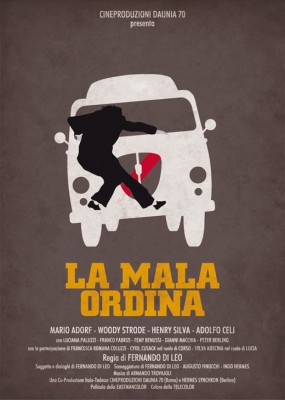
Heading south to Palermo, Sicily but continuing the trilogy's chain of casting associations, The Boss stars Henry Silva, one of the "Americans" (Silva is actually Italian) from The Italian Connection, as Lanzetta, a ferociously loyal aide who was brought in as an orphan and raised by the mob boss he now works for. Lanzetta finds himself an unwitting pawn at the center of an escalating war between two mafia families that eventually reveals absolutely everyone involved (apart from a kidnapped-and-rescued mob princess--a spoiled, drug-addled nympho who falls in love with Lanzetta) to lack any semblance of Lanzetta's loyalty and sense of duty, which have become a liability to him in a game where the only value is attaining the most power and money in the most expedient way possible. Rulers of the City feels like something of an afterthought here: Co-star Jack Palance is aptly and intriguingly snakelike as the villain, but the film's exaggerations seem silly, contrived, and oddly lifeless compared to the raw, ribald luridness of the Milieu Trilogy. With corny one-liners constantly thrown off among the film's overextended fistfights and car chases, this goofy, nonsensical action/buddy picture rather quickly grows tiresome; it's much less Le Samourai than The Dukes of Hazzard.
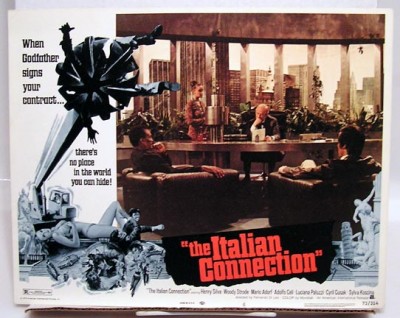
That misstep aside, though, the films are remarkably consistent, each containing its peripheral example of the soulless fascist or naive bleeding-heart on the side of the law (these cops seem to spend most of their time debating politics and philosophy) and all of them shot through with a (sometimes literally) orgiastic too-muchness of color, plot, violence, sex, and action. Di Leo's world is all pool halls, gambling dens, junkyards, highways, nightclubs, anonymous rooms in run-down quarters of cities, or gauchely glamorous/"elegant" mafia flats and mansions. The cinematography (by Franco Villa) and di Leo's shots limn a cartoonish aesthetic that marks itself off quite distinctly from the bold, primary-colored look Raoul Coutard brought to Godard's Pierrot le fou and La Chinoise, or even that created by Vittorio Storaro and Richard Sylbert for Warren Beatty's Dick Tracy. Those films' careful, self-conscious color palettes are Pop Art, whereas Villa and di Leo bestow upon the images in their collaborations an inelegant, smudged, garish, reckless beauty ripped straight from the funny pages, wrinkles, blurs, inky fingers and all. Di Leo constantly, jerkily moves the frame with zooms (out for zippy reveals, in for intense, voyeuristic thrills), and he is forever conjuring up a hand-held immediacy that emits not a documentary vibe, but a hallucinatory one. And not a single one of these films is without di Leo's trademark shot: a handheld, low-angle, round-and-round, extended view of a topless, gyrating foxy lady grooving to one funky nightclub beat or another.
That lady could be a metaphor for these films themselves, which move loosely and hedonistically to their own beat just for the fleeting, expressive fun of it. That beat is concretely present, too, in the form of Luis Enriquez Bacalov's indispensable scores--music that's as integral to the films as any of the performances or camera setups. Whether it's the grimly melancholy melodies he provides for Caliber 9 (adding to that film's particularly Le Samourai-like vibe), the jazz-funk of The Italian Connection score, or the hard-rock rave-ups with which he imbues The Boss, the music is unhinged, eccentric, and memorable in a way that ties right into and enhances the craziness onscreen. These films could even be described as flat-out musical constructions in and of themselves--experiences of the nourishment-free but delectable pop variety. They're just that catchy and exhilarating; they bypass the rational/realist/critical brain centers and rush straight on to the sensory-pleasure receptors, leaving one powerlessly humming along and enjoying every extravagantly overblown note.
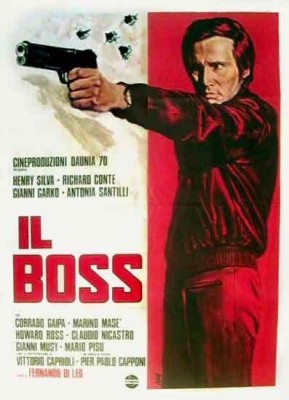
THE BLU-RAY DISCS:
The film's AVC/MPEG-4 encoded, 1080/24p mastered transfers, each presented at the original theatrical aspect ratio of 1.85:1, are decent. There are a few issues: though the aspect ratio is correct, the films have somewhat unusual cropping that, on a larger screen, mats them just the tiniest bit, for an image ever-so-slightly smaller than a normal anamorphic transfer. And although the films' grimy-bold, decaying-brightness color palettes are intact, there is occasional noticeable edge enhancement and a widespread over-use of digital noise reduction leading to some excessive smoothing/slickness of the image (not, however, to the extent that all of the films' celluloid/cinematic texture is removed, so it definitely could have been much worse). The transfers are good, with have no flaws that actually disrupt the visual experience, but they could have been better.
Sound:Each disc presents its film's sound on a Dolby Digital 2.0 mono soundtrack*, and the sound definitely goes the video job one better, with no noticeable flaws or imbalances. Particularly when it comes to the films' distinctive soundtracks, the sound is clear, resonant, and immediate (with the caveat, as always, that the post-synchronized/dubbed dialogue is more artificially prominent in these sound designs than they would have been with direct sound, which is across-the-board standard for Italian films of the period).
*Addendum 01/31/12: Though the packaging states Dolby Digital 2.0 mono, this information is inaccurate; the soundtracks are actually presented in DTS-HD Master Audio 2.0 mono. Thanks to Perry at Gamma Ray Digital for the correction.
Extras:RaroVideo is, as usual, both generous and well-organized when it comes to the supplements they've provided, with extras spread out over the set's four discs and included where most relevant; each film is accompanied by a documentary centering on it alone, while the first disc (Caliber 9) also contains the set's more general, career-spanning extras. Most of the additional programs were directed by Manlio Gomarasca in 2004 for what appears to be a television documentary (or perhaps an earlier Italian DVD re-release) on di Leo and his films, and they all draw on different portions of the same interviews with di Leo himself, collaborators like producer Armando Novello, editor Amedeo Giomini, and composer Luis Enriquez Bacalov, and a cross-section of Italian screenwriters and critics, with cast interviews interspersed where the actor-interviewees appeared in the film under discussion. Everyone is knowledgeable and forthcoming (di Leo himself is an amusingly cranky elderly gentleman, guileless and frank, with idiosyncratic views on many things--his eccentric thoughts on sexuality being among the most memorable--that explain much of the films' cartoonish excess), and the supplements are well worth digging into to find out what all the garish 'n overheated craziness you just saw was all about from both the production end (di Leo and crew) and the reception end, with the critics doing a warmly enthusiastic job of expounding upon the films, their status, and their relation to and place in Italian culture.
Caliber 9 contains three documentaries: the disc-specific "Caliber 9," (30 minutes) a making-of/recollection that also includes interview footage with actor Phillippe Leroy and actress Barbara Bouchet, and the complete career-of-Fernando di Leo overview (going all the way back to his start in the frantically prolific Italian spaghetti Western industry of the '60s), "Fernando di Leo: The Genesis of the Genre" (40 minutes). There is also a 25-minute piece, "Scerbanenco Noir," in which the critics discuss the loose but kindred-spirited relationship between the Italian crime fiction of Giorgio Scerbanenco and the film di Leo adapted from it. Finally, there is a brief (three-minute) slideshow/photo gallery "narrated" by a short telephone interview with cast-against-type actor/comedian Gaston Moschin, star of Caliber 9, in which he reminisces on di Leo, his fellow actors, and their experience of making the film.
The Italian Connection disc's documentary is the 20-minute "The Roots of the Mafia", which brings in actress Francesca Romana Coluzzi (who played the film's sexy bohemian-revolutionary, Trini) to discuss the experience of working with di Leo and the affability of actor Mario Adorf (the film's main character, Luca), and also sees critic Maurizio Colombo comparing the film to Kubrick's The Killing and Melville's Le Cercle rouge.
"Stories About the Mafia" is the 25-minute piece included on The Boss, gathering interviews with actors Gianni Garko (the double-crossing police inspector); Howard Ross, who played the sexy mobster that menacingly comes onto the kidnapped mob boss's daughter, and who discusses how the actors and crew became a "family" that defused the tension of acting out the film's sexuality, particularly for the actress; and Pierpaolo Cappone, who played the vengeful mafia brother and goes into how an actor would build a character and performance with di Leo. Rulers of the City, in its turn, offers a 15-minute piece, "Violent City,", in which the actors and director comment on working with Jack Palance, actor Al Cliver waxes nostalgic about the fun and easygoing time he had making the film while recounting anecdotes about the shoot, and weapons expert Gilberto Galimbati discusses the film's elaborate stunts and gunplay.
Finally, each disc includes an on-screen-text director biography and filmography (the same each time, of course) for handy reference, and the box also contains a 20-page booklet with a bevy of photos from the films, a recap of the director's biography and of each film's credits, and an introduction and extensive interview with di Leo by Italian film writer Luca Rea.
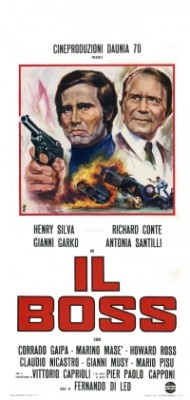
Like a decadent, colorful, fizzy, bad-for-you but oh-so-delicious Italian soda, The Fernando di Leo Crime Collection (well, three-quarters of it, anyway) is a pure sugar rush, a sensationalistic high that comes from such an instinctive, guileless place that it's dizzy, garish fun at even its most potentially tacky or exploitative. Without exception, its gangsters live in a treacherous world of insanely beautiful and willing women, frenzied action and gunfights, and unspeakably violent (not to mention creative and lovingly rendered) death lurking around every corner. They'd never nourish your soul or stimulate your intellect, but if it's genuinely, even purely cheap, excessive thrills you're after, there's no safer bet this side of Faster, Pussycat, Kill! Kill! Just consider the box set proper to consist of the fine Milieu Trilogy of Caliber 9, The Italian Connection, and The Boss, and count the unnecessarily included, asinine Rulers of the City as just a quirky extra, and it comes Highly Recommended.
|
| Popular Reviews |
| Sponsored Links |
|
|
| Sponsored Links |
|
|
| Release List | Reviews | Shop | Newsletter | Forum | DVD Giveaways | Blu-Ray | Advertise |
|
Copyright 2024 DVDTalk.com All Rights Reserved. Legal Info, Privacy Policy, Terms of Use,
Manage Preferences,
Your Privacy Choices | |||||||













